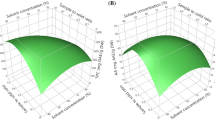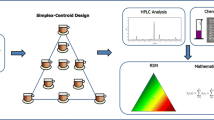Abstract
The popularity of tea is increasing on the global aspect because of its role as a significant source of phenolic compounds in human diet. The objectives of this present study is to develop a supercritical carbon dioxide (SC-CO2) extraction method suitable for extraction of phenolic compounds such as total phenolics, flavonoids and tannin from tea leaves at various extraction conditions such as extraction pressure (100–200 bar), temperature (40–60 °C) and co-solvent (ethanol) flow rate (1–3 g/min). Furthermore, the total antioxidant activity of the SC-CO2 tea leaves extracts was assessed using ABTS+ (2, 2′-azino-bis (3-ethylbenzothiazoline-6-sulphonic acid)) method. Response surface methodology (RSM) combined with Box-Behnken design was used to investigate and optimize the process variables. The results showed that, extraction pressure and co-solvent flow rate have significant effect on the responses. From the experimental data, second order polynomial mathematical models were developed for each response with high coefficient of determination value (R 2 > 0.95). An optimization study using Derringer’s desired function methodology was performed and the optimal conditions based on both individual and combinations of all independent variables (extraction pressure of 188 bar, temperature of 50 °C and co-solvent flow rate of 2.94 g/min) were determined with maximum total phenolic content of 131.24 mg GAE/100 ml, total flavonoid content of 194.60 mg QE/100 ml, total tannin content of 49.99 mg TAE/100 ml and totalantioxidant activity of 262.23 μMol TEAC/100 ml of extracts respectively with a overall desirability value of 0.983, which was confirmed through validation experiments.



Similar content being viewed by others
References
Arnao MB, Cano A, Acosta M (2001) The hydrophilic and lipophilic contribution to total antioxidant activity. Food Chem 73:239–244
Bjorklund E, Jaremo M, Mathiasson L, Jonsson JA, Karlsson L (1998) Illustration of important mechanisms controlling mass transfer in supercritical fluid extraction. Anal Chim Acta 368:117–128
Brunner G (2005) Supercritical fluids: technology and application to food processing. J Food Eng 67:21–33
Chiu KL, Cheng YC, Chen JH, Chang CJ, Yang PW (2002) Supercritical fluid extraction of Ginkgo ginkgolides and flavonoids. J Supercrit Fluids 24:77–87
Derringer G, Suich R (1980) Simultaneous optimization of several response variables. J Qual Technol 12(4):214–219
Ekren O, Ekren BY (2008) Size optimization of a PV/wind hybrid energy conversion system with battery storage using response surface methodology. Appl Energy 85(11):1086–1101
Haggi TM, Anthony DD, Gupta S, Ahmad H, Lee MS, Kumar GK (1999) Prevention of collagen induced arthritis in mice by a polyphenolic fraction from green tea. Proc Natl Acad Sci U S A 96(8):4524–4529
Han X, Cheng L, Zhang R, Bi J (2009) Extraction of safflower seed oil by supercritical CO2. J Food Eng 92:370–376
Hegarty VM, May HM, Khaw KT (2000) Tea drinking and bone mineral density in older women. Am J Clin Nutr 71:1003–1007
Hertog MGL, Hollman PCH, Katan MB, Kromhout D (1993) Estimation of daily intake of potentially anticarcinogenic flavonoids and their determinants in adults in the Netherlands. Nutr Cancer 20:21–29
Huang W, Li Z, Niu H, Li D, Zhang J (2008) Optimization of operating parameters for supercritical carbon dioxide extraction of lycopene by response surface methodology. J Food Eng 89:298–302
Ixtaina V, Vega A, Nolasco S, Tomás M (2010) Supercritical carbon dioxide extraction of oil from Mexican chia seed (Salvia hispanica L.): characterization and process optimization. J Supercrit Fluids 55:192–199
Khan N, Mukhtar H (2007) Tea polyphenols for health promotion. Life Sci 81:519–533
Kumar A, Prasad B, Mishra IM (2007) Process parametric study for ethane carboxylic acid removal onto powder activated carbon using Box–Behnken design. Chem Eng Technol 30(7):927–932
Lang Q, Wai CM (2001) Supercritical fluid extraction in herbal and natural product studies—a practical review. Talanta 53:771–782
Lee YH, Charles AL, Kung HF, Ho CT, Huang TC (2010) Extraction of nobiletin and tangeretin from Citrus depressa Hayata by supercritical carbon dioxide with ethanol as modifier. Ind Crop Prod 31:59–64
Li B, Xu Y, Jin YX, Wu YY, Tu YY (2010) Response surface optimization of supercritical fluid extraction of kaempferol glycosides from tea seed cake. Ind Crop Prod 32:123–128
Lingzhao W, Bao Y, Xiuqiao D, Chun Y (2008) Optimisation of supercritical fluid extraction of flavonoids from Pueraria lobata. Food Chem 108:737–741
Machmudah S, Shotipruk A, Goto M, Sasaki M, Hirose T (2006) Extraction of astaxanthin from Haematococcus pluvialis using supercritical CO2 and ethanol as entrainer. Ind Eng Chem Res 45:3652–3657
Maran JP, Sivakumar V, Sridhar R, Thirgananasambandham K (2013) Development of model for barrier and optical properties of tapioca starch based films. Carbohydr Polym 92:1335–1347
Maron DJ, Lu GP, Cai NS, Wu ZG, Li YH, Chen H (2003) Cholesterol lowering effect of a theaflavin-enriched green tea extract: a randomized controlled trial. Arch Intern Med 163(12):1448–1453
Marr R, Gamse T (2000) Use of supercritical fluids for different processes including new developments—a review. Chem Eng Process 39:19–28
Mohajeri L, Aziz HA, Isa MH, Zahed MA (2010) Statistical experiment design approach for optimizing biodegradation of weathered crude oil in coastal sediments. Bioresour Technol 101:893–900
Otake S, Makimura M, Kuroki T, Nishihara Y, Hirasawa M (1991) Anticaries effects of polyphenolic compounds from Japanese green tea. Caries Res 25:438–443
Park HS, Lee HJ, Shin MH, Lee KW, Lee H, Kim YS (2007) Effects of cosolvents on the decaffeination of green tea by supercritical carbon dioxide. Food Chem 105:1011–1017
Pilavtepe M, Yucel M, Seref Helvaci S, Demircioglu M, Yesil-celiktas O (2012) Optimization and mathematical modeling of mass transfer between Zostera marina residues and supercritical CO2 modified with ethanol. J Supercrit Fluids 68:87–93
Prakash Maran J, Manikandan S (2012) Response surface modeling and optimization of process parameters for aqueous extraction of pigments from prickly pear (Opuntia ficus-indica) fruit. Dye Pigment 95:465–472
Prakash Maran J, Manikandan S, Thirugnanasambandham K, Vigna Nivetha C, Dinesh R (2013a) Box-Behnken design based statistical modeling for ultrasound-assisted extraction of corn silk polysaccharide. Carbohydr Polym 92:604–611
Prakash Maran J, Manikandan S, Vigna Nivetha C, Dinesh R (2013b) Ultrasound assisted extraction of bioactive compounds from Nephelium lappaceum L. fruit peel using central composite face centered response surface design. Arab J Chem. doi:10.1016/J.arabjc.2013.02.007
Prakash Maran J, Mekala V, Manikandan S (2013c) Modeling and optimization of ultrasound-assisted extraction of polysaccharide from Cucurbita moschata. Carbohydr Polym 92:2018–2026
Prakash Maran J, Sivakumar V, Sridhar R, Prince Immanuel V (2013d) Development of model for mechanical properties of tapioca starch based films. Ind Crop Prod 42:159–168
Prakash Maran J, Sivakaumar V , Thirgananasambandham K, Sridhar R (2013e) Model development and process optimization for solvent extraction of polyphenols from red grapes using Box- Behnken design. Prep Biochem Biotech. doi:10.1080/10826068.2013.791629
Priya B, Viswanathan R, Vairamani M (2013) Response surface optimisation of process variables for microencapsulation of garlic (Allium sativum L.) oleoresin by spray drying. Biosyst Eng 114:205–213
Rostagno MA, Araújo JMA, Sandi D (2002) Supercritical fluid extraction of isoflavones from soybean flour. Food Chem 78:111–117
Salgin S, Salgin U (2006) Supercritical fluid extraction of walnut kernel oil. Eur J Lipid Sci Technol 108:577–582
Scalia S, Giuffreda L, Pallado P (1999) Analytical and preparative supercritical fluid extraction of Chamomile flowers and its comparison with conventional methods. J Pharm Biomed Anal 21:549–558
Shirin Adel PR, Prakash J (2010) Chemical composition and antioxidant properties of ginger root (Zingiber officinale). J Med Plant Res 4(24):2674–2679
Soto C, Conde E, Moure A, Zúñiga ME, Dominguez H (2008) Supercritical extraction of borage seed oil coupled to conventional solvent extraction of antioxidants. Eur J Lipid Sci Technol 110:1035–1044
Vatai T, Kerget MS, Knez Z (2009) Extraction of phenolic compounds from elder berry and different grape marc varieties using organic solvents and/or supercritical carbon dioxide. J Food Eng 90:246–254
Vinson JA, Zhang J (2005) Black and green teas equally inhibit diabetic cataracts in a streptozotocin-induced rat model of diabetes. J Agric Food Chem 53(9):3710–3713
Vinson JA, Teufel K, Wu N (2004) Green and black teas inhibit atherosclerosis by lipid, antioxidant, and fibrinolytic mechanisms. J Agric Food Chem 52:3661–3665
Young W, Hotovec RL, Romero AG (1967) Tea and atherosclerosis. Nature 216:1015–1016
Zhishen J, Mengchang T, Jianming W (1999) The determination of flavonoid contents in mulberry and their scavenging effects on superoxide radicals. Food Chem 64:555–559
Author information
Authors and Affiliations
Corresponding author
Rights and permissions
About this article
Cite this article
Maran, J.P., Manikandan, S., Priya, B. et al. Box-Behnken design based multi-response analysis and optimization of supercritical carbon dioxide extraction of bioactive flavonoid compounds from tea (Camellia sinensis L.) leaves. J Food Sci Technol 52, 92–104 (2015). https://doi.org/10.1007/s13197-013-0985-z
Revised:
Accepted:
Published:
Issue Date:
DOI: https://doi.org/10.1007/s13197-013-0985-z




